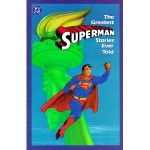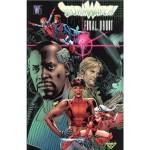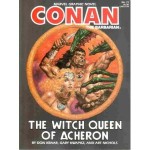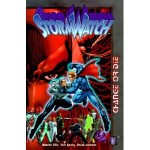

By Jerry Siegel, Joe Shuster & various (DC Comics)
ISBN: 978-0-930289-29-3Â paperback ISBN: 978-0-9302893-9-3
When graphic novels were just establishing themselves as a separate collector commodity in the late 1980s DC launched an ambitious series of themed hardback compendiums celebrating “The Greatest Stories …†but after not nearly enough comprehensive chronicles the project was shelved. The title was revived early this century in a glossy, stripped down softcover format and continues intermittently to this day, exclusively focusing on individual heroes and titles.
One of the first of these collections naturally featured the Big Gun who started it all and this compelling array of fantastic adventures, also commemorating fifty years of Super Action, is as intriguing for what’s omitted as it is enticing for its included contents. After all, how do you pick 340 pages out of the incalculable thousands of magic moments filled with the exploits of one of the greatest and most enduring characters in world fiction?
Giving it a shot in 1987 – not long after the immensely successful reboot that came after Crisis on Infinite Earths – were co-editors Mike Gold and Robert Greenberger, who explain their methodology in ‘Gathering the Greatest’ and ‘End Notes’ respectively. Also contributing a weighty text treatise was John Byrne, the then architect of the Man of Steel’s new adventures who trace ‘The Origins of Superman’ in his lengthy but fascinating introduction.
After those passionate prose pieces the action begins with Jerry Siegel and Joe Shuster’s ‘Superman versus Luthor’ from Superman #4 (Spring 1940); a landmark first clash with the rogue scientist who, back then, was a rangy red-headed menace with a bald and pudgy henchman. Somehow he got confused with his boss in later adventures and became the slap-headed super-criminal we know today…
Full-on villains were few and far between back then but ‘Superman versus The Archer’ is cited as introducing the first costumed foe Superman ever faced (from #13, November-December 1941, credited here to Siegel and Shuster, but actually mostly the artwork of Superman Studio stalwart Leo Nowak) a riotous murder-mystery matched in energy and simplistic enthusiasm by the two-page feature ‘What if Superman Ended the War?’ from the tabloid Look Magazine (February 1940) wherein Hitler and Stalin, instigators of that distant “second European War†were hauled off to the World Court by the irresistible Man of Tomorrow. Once America joined the melee Superman was constrained to be far more circumspect…
‘The Mysterious Mr. Mxyztplk’ (Superman #30, September-October 1944, credited to Siegel and John Sikela, but actually drawn by Ira Yarborough) introduced the fifth dimensional imp who periodically tested the Man of Steel’s ingenuity and patience in a still hilarious perfect example of daffy screwball comedy. Much-reprinted, but always glorious, Mxyztplk (later Anglicised to Mxyzptlk, presumably to make it easier to spell) became a cornerstone of the Superman mythos: an insufferable pixie, against whom all Superman’s strength and power were useless. From then on brains were going to be as important as brawn as they introduced frustration as the Big Guy’s first real weakness.
We jump all the way to the 10th Anniversary issue for ‘The Origin of Superman’ (from Superman #53, July-August 1948, by Bill Finger & Wayne Boring) as new editor Mort Weisinger began expanding the mythology by introducing the heritage of lost Krypton to a new generation of fans.
From Superman #123 (August 1958) ‘The Girl of Steel’ by Otto Binder, Dick Sprang & Stan Kaye trialed the concept of a distaff Supergirl as part of a three-chapter yarn involving a magic wishing totem (the other two segments ‘The Lost Super-Powers’ and ‘Superman’s Return to Krypton’ are also included and just as impressive) whilst ‘Clark Kent’s College Days’ (#125, October-November 1958) by Jerry Coleman & Al Plastino) began an occasional series of ‘Untold Tales of Superman’ by revealing how, when and why Superboy became the Man of Steel.
From the same year Action Comics #241 provided ‘The Key to Fort Superman’ an intriguing puzzle-play featuring Batman, written by Coleman and illustrated by Boring & Kaye, whilst another major player in the Metropolis Marvel’s canon debuted in the captivatingly tragic 3-part novel ‘The Battle With Bizarro’ (Superboy #68, October 1958) by Binder & George Papp. That Silver Age also introduced the bewitching mermaid Lori Lemaris in ‘The Girl In Superman’s Past’ – another Untold Tale of Superman by Finger & Boring which originally surfaced in Superman #129 (May, 1959).
By the late 1950s Superman had settled into an ordered existence. Nothing could really hurt him, nothing would ever change, and thrills seemed in short supply. With the TV show cementing the action, writers increasingly concentrated on supplying wonder instead. ‘Superman’s Other Life’ by Binder, Boring & Kaye (Superman #132, October 1959) shows what might have happened if Superman had grown up on an unexploded Krypton, courtesy of Batman and the projections of a super-computer.
This momentous costumed drama is counter-pointed by the deliciously whimsical and bizarre mystery romp ‘The Night of March 31st‘ (Binder, Curt Swan & Sheldon Moldoff from Superman #145, May 1961) and the compelling epic ‘The Death of Superman’ from #149 (November 1961, by Siegel, Swan & George Klein – possibly the most effective art-team ever to work on the Man of Steel).
They also illustrated Leo Dorfman’s ‘The Amazing Story of Superman-Red and Superman-Blue!’ (Superman #162, July 1963) possibly the most influential tale of this entire sub-genre and a perfect response to the tragedy of the previous saga: a startling utopian classic so well-received that decades later it influenced and flavoured the post-Crisis on Infinite Earths Superman continuity for months.
When Julie Schwartz took over the editorial duties in 1970, he decided to shake things up with spectacular results, but before then a brilliant but off-the-wall inclusion here is ‘The Forever People!’ (Forever People #1, February 1971, by Jack Kirby, Vince Colletta and infamously, Al Plastino who was engaged to redraw Superman’s head), a stunning tour de force of wonderment which introduced “The King’s†Fourth World universe to fans, instantly changing the way DC Comics were perceived and how the medium could be received.
Schwartz breathed fresh life into the Superman franchise when his editorial changes took hold in 1971, spearheading controversial and socially challenging material unheard of since the feature’s earliest days. From Superman #247 (January 1972) comes a groundbreaking yarn by Elliot Maggin, Swan and Murphy Anderson which questioned the nigh-omniscient hero’s effect on human development and self-reliance in ‘Must There be a Superman?’
Alan Moore & Dave Gibbons produced one of the last great Superman stories before the great upheaval of Crisis on Infinite Earths with ‘For the Man Who Has Everything’ (Superman Annual #11, 1985) as the alien despot Mongul attacks the Man of Tomorrow with the most insidious of weapons and not even Batman, Robin and Wonder Woman are enough to turn the tide…
When DC Comics decided to rationalise and reconstruct their continuity with Crisis on Infinite Earths they used the event to regenerate their key properties. The biggest shake-up was Superman and it’s hard to argue that change was unnecessary. The old soldier was in a bit of a slump, but he’d weathered those before. So how could a root and branch overhaul be anything but a marketing ploy that would alienate real fans for a few fly-by-night chancers who would jump ship as soon as the next fad surfaced?
Superman’s titles were cancelled/suspended for three months, and boy, did that make the media sit-up and take notice – for the first time since the Christopher Reeve movie. But there was method in this corporate madness…
Man of Steel, written and drawn by John Byrne and inked by Dick Giordano stripped away vast amounts of accumulated baggage and retuned the hero to the far from omnipotent edgy but good hearted reformer Siegel and Shuster had first envisioned. It was a huge and instant success, becoming the industry’s premiere ‘break-out’ hit and from that overwhelming start Superman returned to his suspended comic-book homes with the addition of a third monthly title premiering in the same month.
The miniseries presented six complete stories from key points in Superman’s career, reconstructed in the wake of the aforementioned Crisis and ‘The Secret Revealed’ (by Byrne & Terry Austin) comes from the second issue of that remodeled, Post-Crisis, Superman (July 1986) ending this glorious compendium with satisfactory circularity by revealing just how differently the new Lex Luthor thought and worked: a new kind of arch villain for the Reagan era…
Every generation has its own favourite Superman. This selection has the potential to make a fan reconsider just which one that might be. It’s probably wiser to just love them all…
© 1940-1986, 1987 DC Comics, Inc. All Rights Reserved.











